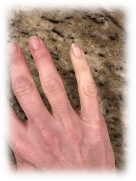Preserving your hands in dental hygiene
Dexterity and tactile sensitivity are essential for oral health-care practitioners to perform dental procedures; these abilities are critical for caring for patients. Several conditions, often due to overuse of the hands, can cause hand degradation and reduce a dental professional’s ability to perform care.
Overuse of your hands from performing repetitive motions can cause temporary or long-lasting effects on your professional skills. These continuous stress injuries could affect the hand muscles, ligaments, tendons, nerves, and joints. There are many contributing factors associated with the longevity, skill, and tactile sensitivity of your hands. All of the conditions listed here can affect your ability to perform at an optimal level. Risk factors for these conditions—and I have experienced some—are multifactorial.
Raynaud’s syndrome
This phenomenon tends to run in families; however, the inheritance pattern is unknown. Typical episodic attacks may last for less than one hour or continue for several hours. Depending on the type of Raynaud’s a person is diagnosed with, treatment options include preparing for cold environments, lifestyle changes, and rarely, surgery. Those with secondary Raynaud’s may be treated with medications.1
Carpal tunnel syndrome
Carpal tunnel syndrome, first recognized by Sir James Paget in 1864, is a disorder of the wrist’s median nerve. The disorder took almost 100 years to be accepted in the medical profession. Carpal tunnel syndrome has become the most frequently diagnosed hand condition since 1960 and is most prevalent among those with work-related repetitive hand motions, such as dentists, assistants, and dental hygienists, among other health-care professionals.2
Symptoms of carpal tunnel include frequent numbness or tingling of the fingers and, in more severe cases, swelling. There are numerous causes of carpal tunnel syndrome, such as the overuse of vibrating instruments, the development of a cyst or tumor on the hand or wrist, and other contributing factors such as trauma to the area.3
Treatment for carpal tunnel includes splinting or bracing, nonsteroidal anti-inflammatory drugs (NSAIDs), exercises, and corticosteroid injections. I have experienced splinting and bracing during nonclinical hours and stretching to alleviate Raynaud’s symptoms.
Ganglion cysts
Ganglion cysts are benign connective tissue masses that form as fluid-filled lumps in the hand or wrist and often appear near joints and tendons.4 Sixty to 70% of ganglion cysts within the body are found in the dorsal aspect of the wrist while 13%–20% of ganglion cysts are found on the volar aspect of the wrist.4
This type of cyst irritates the tendon or joint and is often painful due to its pressure on the surrounding areas. Injuries to these areas could exacerbate the effects of a particular cyst. A ganglion cyst is noncancerous, can occur in any joint, and sometimes dissipates independently.4
Surgical and nonsurgical treatments are available. Some treatments include aspiration, splints and anti-inflammatory medications, or surgery to remove the cyst wall and fluid. Surgery may also involve removing a portion of the joint capsule or tendon sheath.5 Even after removing a cyst there’s a chance that it may return. Thankfully, my cyst dissipated on its own and has not resurfaced.
Tendinitis
Tendinitis is associated with different types of musculoskeletal disorders such as De Quervain’s tenosynovitis, rotator cuff syndrome, and lateral and medial epicondylitis.3 This musculoskeletal disorder is a common hindrance among dental professionals in the upper extremities, wrists, elbows, and hands. Tendinopathies are afflictions of the tendons due to repetitive work, lack of ergonomics, and vibration while using dental instruments.3
Treatment options for tendinitis may include electrical stimulation or heat therapy, which is one of the procedures that I experienced early in my career. I also had this ailment while experiencing Raynaud’s for the first time during the cold winter months, and I had pain in my forearms and could not move my hands freely. I spent a few weeks being treated with electrical stimulation and did exercises at home to improve mobility. Other treatment options include splinting and bracing, which are similar to carpal tunnel syndrome treatment.
Rheumatoid arthritis
Rheumatoid arthritis (RA) is a common inflammatory autoimmune disorder that can hinder a dental professional’s abilities in the operatory. RA affects the lining of the synovial joints, which leads to swelling around the joints and limits range of motion. This ailment not only affects the joints but can also affect organs such as the heart and lungs. RA occurs more frequently in females than in males.7
According to the Centers for Disease Control and Prevention (CDC), RA can have debilitating effects on the hands and knees, leading to lack of balance, deformity, and chronic pain.8 People with RA often have other comorbidities, such as periodontal disease, temporomandibular dysfunction, cardiovascular disease, type 2 diabetes, osteoporosis, Parkinson’s disease, Alzheimer’s disease, psoriasis, respiratory infections, and salivary gland dysfunction.9
Final thoughts
Dexterity, tactile sensitivity, and how long you can perform at an optimal level are important. As oral health-care professionals, we need to be aware of these musculoskeletal disorders, the treatments available, and the ergonomic equipment available to prevent or decrease the effects of this work-related pain that may arise during our career.
References
1. Temprano KK. A review of Raynaud’s disease. Mo Med. 2016;113(2):123-126.
2. Gerwatowski LJ, McFall DB, Stach DJ. Carpal tunnel syndrome. Risk factors and preventive strategies for the dental hygienist. J Dent Hyg. 1992;66(2):89-94.
3. Werner RA, Hamann C, Franzblau A, Rodgers PA. Prevalence of carpal tunnel syndrome and upper extremity tendonitis among dental hygienists. J Dent Hyg. 2002;76(2):126-132.
4. What is a ganglion cyst? American Society for Surgery of the Hand. 2020. https://www.assh.org/handcare/condition/ganglion-cyst
5. Kissel JA, Wong C. Ganglion cyst of the wrist treated with electroacupuncture: a case report. J Can Chiropr Assoc. 2017;61(3):269-276.
6. de Souza S, Bansal RK, Galloway J. Rheumatoid arthritis–an update for general dental practitioners. Br Dent J. 2016;221(10):667-673. doi:10.1038/sj.bdj.2016.866
7. Treister N, Glick M. Rheumatoid arthritis: a review and suggested dental care considerations. J Am Dent Assoc. 1999;130(5):689-698. doi:10.14219/jada.archive.1999.0279
8. What is rheumatoid arthritis. Centers for Disease Control and Prevention, July 27, 2020. https://www.cdc.gov/arthritis/basics/rheumatoid-arthritis.html
9. Holmstrup P, Damgaard C, Olsen I, et al. Comorbidity of periodontal disease: two sides of the same coin? An introduction for the clinician. J Oral microbiol.2105 2017;9(1). doi:10.1080/20002297.2017.1332710
LACY WALKER, RDH, CDA, is a practicing periodontal dental hygienist, CE director for A Tale of Two Hygienists podcast, associate member of AAOSH, a blogger, and research assistant for Connect the Dents. She has more than 23 years of experience in the dental industry, including cosmetic, restorative, DSO, and general practices. Walker has a passion for the oral-systemic connection and is a published author in DrBicuspid. She can be reached at [email protected], [email protected], or visit shygienist.com.
About the Author

Lacy Walker, BS, RDH, CDA, MAADH, FAAOSH,
Lacy Walker, BS, RDH, CDA, MAADH, FAAOSH, is an international speaker, author of the book Choices, and owner of Shared Hygiene. She’s worked in periodontal, psychiatric hospitals, cosmetic, DSOs, and general private and military practices. Lacy is the CE director for A Tale of Two Hygienists podcast and the public relations chair, president-elect for the American Academy of Dental Hygiene, and one of the founding members of RDH Connect. She's passionate about the oral-systemic connection. Contact her at [email protected], @lacyrdh, @shygienist, or visit sharedhygiene.com.


